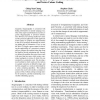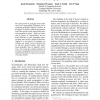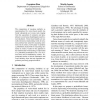101
click to vote
EMNLP
2010
14 years 11 months ago
2010
Determining whether two terms in text have an ancestor relation (e.g. Toyota and car) or a sibling relation (e.g. Toyota and Honda) is an essential component of textual inference ...
EMNLP
2010
14 years 11 months ago
2010
Syntactic consistency is the preference to reuse a syntactic construction shortly after its appearance in a discourse. We present an analysis of the WSJ portion of the Penn Treeba...
85
Voted
EMNLP
2010
14 years 11 months ago
2010
Linguistic Steganography is concerned with hiding information in natural language text. One of the major transformations used in Linguistic Steganography is synonym substitution. ...
130
click to vote
EMNLP
2010
14 years 11 months ago
2010
We describe a model for the lexical analysis of Arabic text, using the lists of alternatives supplied by a broad-coverage morphological analyzer, SAMA, which include stable lemma ...
97
Voted
EMNLP
2010
14 years 11 months ago
2010
Although many algorithms have been developed to harvest lexical resources, few organize the mined terms into taxonomies. We propose (1) a semi-supervised algorithm that uses a roo...
103
click to vote
EMNLP
2010
14 years 11 months ago
2010
This work concerns automatic topic segmentation of email conversations. We present a corpus of email threads manually annotated with topics, and evaluate annotator reliability. To...
75
Voted
EMNLP
2010
14 years 11 months ago
2010
Strong indications of perspective can often come from collocations of arbitrary length; for example, someone writing get the government out of my X is typically expressing a conse...
97
Voted
EMNLP
2010
14 years 11 months ago
2010
Conventional wisdom dictates that synchronous context-free grammars (SCFGs) must be converted to Chomsky Normal Form (CNF) to ensure cubic time decoding. For arbitrary SCFGs, this...
86
Voted
EMNLP
2010
14 years 11 months ago
2010
The rapid growth of geotagged social media raises new computational possibilities for investigating geographic linguistic variation. In this paper, we present a multi-level genera...
111
Voted
EMNLP
2010
14 years 11 months ago
2010
The computation of meaning similarity as operationalized by vector-based models has found widespread use in many tasks ranging from the acquisition of synonyms and paraphrases to ...



